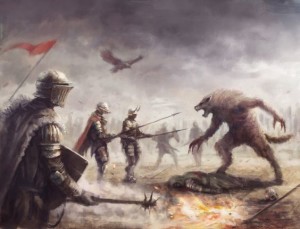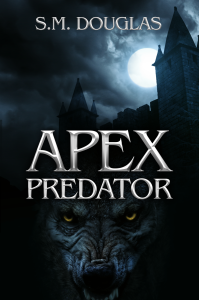As everybody who follows me on social media knows I have been on a historical werewolf kick. Perhaps this should be no surprise given that my new book Apex Predator features several chapters set during the Second World War (chapters an actual WWII historian edited). However, Apex Predator also has several other nuggets for the fan of historical or classic werewolf mythology. To that end it offers what I hope to be an interesting take on the werewolf origin story, which this superb artwork by Jakub Rozalski in part encapsulates – at least in terms of showing the era in which my werewolves first took form.

In Apex Predator this is all further fleshed out as several primary characters grapple with the fact they are being hunted and try to figure out how to not only survive but also gather enough evidence to prove werewolves do exist and thus get help. I have long been interested by the idea of being hunted by a monster but having no one to get help from because no one would believe it – so I also incorporated that into my novel. But I digress. I have also long been fascinated by the interplay between man and his surrounding environment; particularly at those catastrophic times when nature strikes back. Perhaps no such time was more deadly than during the Black Plague; a time very much salient to that of my novel.
The plague germ Yersinia pestis had been the cause of horrific epidemics before the Black Plague put its stamp on human history in the 14th Century. For instance during the Athenian Plague of 430 BCE; the Antonine Plague of 165-180 CE; and the Justinian Plague, 541 CE, which was the most deadly outbreak prior to the Black Death. However, none of those outbreaks compared to the Black Death; which for reasons unknown proved particularly adept at producing DNA mutations in humans.
What we know is that what made the Black Death so deadly came from how easily it spread. It ended up killing millions in Asia, and as many as one third of Europe’s population was wiped out in large part because the Black Death spread like wildfire. What is most stunning is that all of this happened for a reason. The Black Death wasn’t an accident, it was the product of a unique set of circumstances fueled by overpopulation, malnutrition, weakened immune systems, climate change, globalized trade, and gross inequality producing a vast human underclass. In addition, this particular strain of plague not only stemmed from a germ carried by simple fleas but which gestated in the body of a small furry animal: the Central Asian marmot. This particular marmot as a host ended up being the perfect vehicle for incubating the plague into something more powerful and dangerous than plague strains found elsewhere in the world.
Trade with Central Asia brought this strain west into the growing slums of Europe’s great cities. Though the marmot incubated strains of plague proved the deadliest – people, not marmots, spread the plague. This plague not only spread, but quickly adapted to and transformed its new human host. This adaptation proved to be an evolutionary process stemming from the action of natural selection, rather than just a series of incidental mutations. Similarly, in Apex Predator these mutations also prove to be anything but random or meaningless. They are part of a process whereby natural selection created another evolutionary response; one every bit as deadly though more circumspect than Yersinia pestis.


Leave a Reply